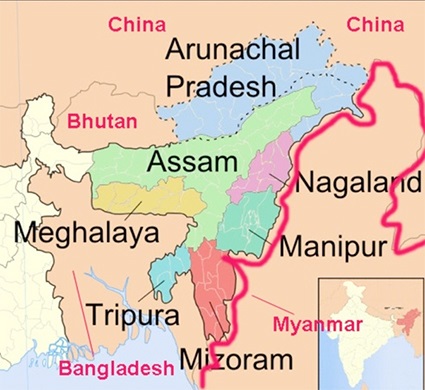Myanmar Refugees Can Approach UNHCR: Manipur HC | 04 May 2021
Why in News
The High Court of Manipur has ordered safe passage to seven Myanmar nationals, stranded at a border town in Manipur, to travel to the United Nations High Commissioner for Refugees (UNHCR) in New Delhi.
- The seven nationals entered India secretly after the military coup in Myanmar.
- The coup returned Myanmar to full military rule after a short span of quasi-democracy that began in 2011, when the military, which had been in power since 1962, implemented parliamentary elections and other reforms.
Key Points
- Observation made by Manipur HC:
- Although India has no clear refugee protection policy or framework, it does grant asylum to a large number of refugees from the neighbouring country.
- India usually respects UNHCR’s recognition of the status of such asylum seekers, mainly from Afghanistan and Myanmar.
- Though India is not a party to the UN Refugee Conventions, it is a party to the Universal Declaration of Human Rights of 1948 and the International Covenant on Civil and Political Rights of 1966.
- Article 21 of the Constitution encompasses the right of non-refoulement.
- Non-refoulement is the principle under international law which states that a person fleeing persecution from his own country should not be forced to return to his own country.
- Although India has no clear refugee protection policy or framework, it does grant asylum to a large number of refugees from the neighbouring country.
- India-Myanmar Border:

- Bordering States: India and Myanmar share a 1,643 km border and people on either side have familial ties.
- Arunachal Pradesh shares 520 kms.
- Nagaland shares 215 kms.
- Manipur shares 398-km.
- Mizoram shares 510-km.
- The border along the four states is unfenced and porous.
- Free Movement Regime (FMR):
- A Free Movement Regime (FMR) exists between India and Myanmar.
- Under FMR, every member of the hill tribes, who is either a citizen of India or a citizen of Myanmar and who is resident of any area within 16 km on either side of the Indo-Myanmar Border (IMB) can cross the border with a border pass (with one-year validity) issued by the competent authority and can stay up to two weeks per visit.
- Recent Influx of People from Myanmar:
- India already has a lot of Rohingya migrated from Myanmar.
- Rohingyas are ethnic Muslims of Myanmar living in Rakhine province in the Arakan region.
- About 1,68,000 Rohingyas had fled Myanmar since 2012, when clashes with Buddhists erupted in the trouble-torn Arakan region.
- Since the Myanmar Army seized power on 1st February 2021, there has been an influx of people into India’s north eastern states.
- Many of them are democracy activists belonging to the Chin ethic group, or policemen who said they disobeyed orders to shoot at protesters.
- India already has a lot of Rohingya migrated from Myanmar.
- Bordering States: India and Myanmar share a 1,643 km border and people on either side have familial ties.
- India’s Stand on Refugees:
- India has welcomed refugees in the past, and on date, nearly 3,00,000 people here are categorised as refugees. But India is not a signatory to the 1951 Refugee Convention or its1967 Protocol. Nor does India have a refugee policy or a refugee law of its own.
- This has allowed India to keep its options open on the question of refugees. The government can declare any set of refugees as illegal immigrants — as has happened with Rohingya despite the UNHCR verification — and decide to deal with them as trespassers under the Foreigners Act or the Indian Passport Act.
- The closest India has come to a refugee policy in recent years is the Citizenship Amendment Act, 2019, which discriminates between refugees on the basis of religion in offering them Indian citizenship.
United Nations Refugee Convention 1951
- It is a United Nations multilateral treaty that defines who is a refugee, and sets out the rights of individuals who are granted asylum and the responsibilities of nations that grant asylum.
- It also set out which people do not qualify as refugees, such as war criminals.
- It grants certain rights to people fleeing persecution because of race, religion, nationality, affiliation to a particular social group, or political opinion.
- It builds on Article 14 of the Universal Declaration of Human Rights 1948, which recognizes the right of persons to seek asylum from persecution in other countries.
- The 1967 Protocol included refugees from all countries as opposed to the 1951 Convention that only included refugees from Europe.
- India is not a party to this convention.
United Nations High Commissioner for Refugees
- United Nations High Commissioner for Refugees (UNHCR) is a UN Refugee Agency and a global organization dedicated to saving lives, protecting the rights and building a better future for refugees, forcibly displaced communities and stateless people.
- It was created in 1950 to help millions of Europeans who had fled or lost their homes.
- It is headquartered at Geneva, Switzerland.
